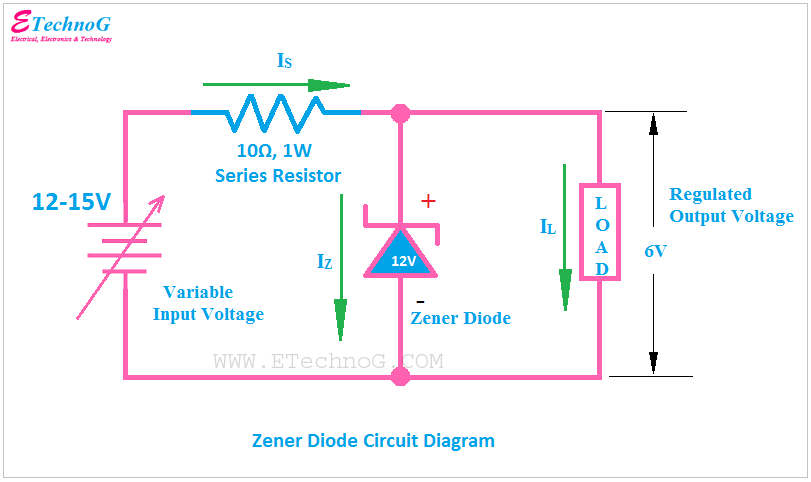Zener Diode Circuit Diagram for Voltage Regulation
Hey, in this article we are going to see Zener Diode Circuit Diagram. This circuit diagram of Zener Diode is for Voltage Regulation. This circuit will help you to understand exactly how a Zener Diode Works. Zener Diode is a semiconductor Device specially designed to operate in reverse bias. It is a heavily doped semiconductor device. When a reverse voltage is applied across the Zener Diode and when it reaches the Zener voltage or knee voltage it starts to conduct current in reverse bias.
Actually, what happened, when the reverse voltage across the Zener diode reaches the Zener voltage, the junction of the Zener diode breaks down and it conducts current. Basically, the Zener diode regulates the voltage by exploiting its unique characteristic called the Zener breakdown or Zener effect. So when a Zener diode is reverse-biased and the voltage across its terminals exceeds the Zener voltage (breakdown voltage), it starts conducting in the reverse direction. This causes a controlled amount of current to flow through the diode, effectively maintaining a constant voltage drop across its terminals. As a result, the Zener diode acts as a voltage regulator by limiting the voltage to its specified Zener voltage regardless of changes in the input voltage or load conditions.
Here, are the key points and tips for connection when you want to use a Zeer diode as a voltage Regulator,
- Determine the desired output voltage you want to regulate.
- Choose a Zener diode with a slightly higher breakdown voltage than the desired output voltage.
- Connect the Zener diode in reverse (backward) across the load.
- Optionally, add a current-limiting resistor in series with the Zener diode to control the current.
- Connect the load (device or circuit) across the Zener diode.
- Apply power by connecting the input voltage.
- Measure the output voltage to ensure it is regulated and within the desired range.
Remember that using just a Zener diode may not be suitable for high-power applications or precise voltage regulation. In those cases, additional components and circuits may be necessary.
Zener Diode Circuit Diagram
Here, you can see the circuit diagram of the Zener Diode for voltage regulation. We have designed this circuit for an example purpose by following the above tips and procedures. You can made your own regulator circuit like this.
The rating of the Zener diode is most important when you are going to make a voltage regulator circuit. If you want the output voltage 5V then you must select a Zener diode having a rating Zener voltage 5V. So it is cleared that the output voltage of the voltage regulator circuit completely depends upon the Zener voltage rating of the Zener diode.
Here, in the above circuit diagram, we have used a 12V Zener Diode. So we will get a constant 12V DC output voltage even when the input voltage increases above 12V.
Now, let's know how this circuit works?
You can see the Zener diode is connected in reverse bias. So when the input voltage is 12V or less than 12V it does not conduct any current, so the voltage drop across the series resistor is nothing. So the output voltage will be the same as the input voltage. But when the input voltage increases above the 12V, the junction of the Zener diode will be broken down, and it will start conducting current. When the Zener diode conducts current, a voltage drop will occur in the series resistor. This voltage drop will decrease the input voltage and keep maintain a constant 12V voltage at the output.
Zener diode not only maintains the constant output voltage when input voltage increases, but it also maintains the constant output voltage during overload, load fluctuation, etc. When the load consumes more current, the current flowing through the Zener diode will decrease and when the load consumes less current, the current flowing through the Zener diode will increase. Thus a Zener diode keeps maintaining a constant output voltage during load variation.
Applications
Voltage regulator circuits using Zener diodes are used in low-cost electronic devices such as small battery chargers, electronic timers, electronic drivers, etc.
Disadvantages
The main disadvantage of the voltage regulator using the Zener diode is power loss. A Zener diode regulates the voltage by flowing current through itself as well as the series resistor. So the series resistor causes a continuous power loss.
Another disadvantage is the chances of avalanche breakdown of the Zener diode. If the input voltage of the circuit goes extremely high, then an avalanche breakdown will occur in the Zener diode. Once the avalanche breakdown occurs in the Zener diode, it will allow flowing current through it continuously even when the voltage decrease than the Zener voltage.
Read Also:

